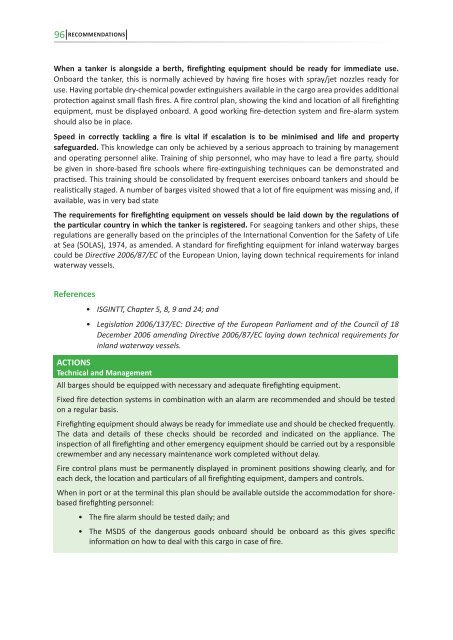Carriage, Handling and Storage of Dangerous Goods along
Carriage, Handling and Storage of Dangerous Goods along
Carriage, Handling and Storage of Dangerous Goods along
You also want an ePaper? Increase the reach of your titles
YUMPU automatically turns print PDFs into web optimized ePapers that Google loves.
96 RECOMMENDATIONS<br />
When a tanker is <strong>along</strong>side a berth, firefighting equipment should be ready for immediate use.<br />
Onboard the tanker, this is normally achieved by having fire hoses with spray/jet nozzles ready for<br />
use. Having portable dry-chemical powder extinguishers available in the cargo area provides additional<br />
protection against small flash fires. A fire control plan, showing the kind <strong>and</strong> location <strong>of</strong> all firefighting<br />
equipment, must be displayed onboard. A good working fire-detection system <strong>and</strong> fire-alarm system<br />
should also be in place.<br />
Speed in correctly tackling a fire is vital if escalation is to be minimised <strong>and</strong> life <strong>and</strong> property<br />
safeguarded. This knowledge can only be achieved by a serious approach to training by management<br />
<strong>and</strong> operating personnel alike. Training <strong>of</strong> ship personnel, who may have to lead a fire party, should<br />
be given in shore-based fire schools where fire-extinguishing techniques can be demonstrated <strong>and</strong><br />
practised. This training should be consolidated by frequent exercises onboard tankers <strong>and</strong> should be<br />
realistically staged. A number <strong>of</strong> barges visited showed that a lot <strong>of</strong> fire equipment was missing <strong>and</strong>, if<br />
available, was in very bad state<br />
The requirements for firefighting equipment on vessels should be laid down by the regulations <strong>of</strong><br />
the particular country in which the tanker is registered. For seagoing tankers <strong>and</strong> other ships, these<br />
regulations are generally based on the principles <strong>of</strong> the International Convention for the Safety <strong>of</strong> Life<br />
at Sea (SOLAS), 1974, as amended. A st<strong>and</strong>ard for firefighting equipment for inl<strong>and</strong> waterway barges<br />
could be Directive 2006/87/EC <strong>of</strong> the European Union, laying down technical requirements for inl<strong>and</strong><br />
waterway vessels.<br />
References<br />
• ISGINTT, Chapter 5, 8, 9 <strong>and</strong> 24; <strong>and</strong><br />
• Legislation 2006/137/EC: Directive <strong>of</strong> the European Parliament <strong>and</strong> <strong>of</strong> the Council <strong>of</strong> 18<br />
December 2006 amending Directive 2006/87/EC laying down technical requirements for<br />
inl<strong>and</strong> waterway vessels.<br />
ACTIONS<br />
Technical <strong>and</strong> Management<br />
All barges should be equipped with necessary <strong>and</strong> adequate firefighting equipment.<br />
Fixed fire detection systems in combination with an alarm are recommended <strong>and</strong> should be tested<br />
on a regular basis.<br />
Firefighting equipment should always be ready for immediate use <strong>and</strong> should be checked frequently.<br />
The data <strong>and</strong> details <strong>of</strong> these checks should be recorded <strong>and</strong> indicated on the appliance. The<br />
inspection <strong>of</strong> all firefighting <strong>and</strong> other emergency equipment should be carried out by a responsible<br />
crewmember <strong>and</strong> any necessary maintenance work completed without delay.<br />
Fire control plans must be permanently displayed in prominent positions showing clearly, <strong>and</strong> for<br />
each deck, the location <strong>and</strong> particulars <strong>of</strong> all firefighting equipment, dampers <strong>and</strong> controls.<br />
When in port or at the terminal this plan should be available outside the accommodation for shorebased<br />
firefighting personnel:<br />
• The fire alarm should be tested daily; <strong>and</strong><br />
• The MSDS <strong>of</strong> the dangerous goods onboard should be onboard as this gives specific<br />
information on how to deal with this cargo in case <strong>of</strong> fire.













